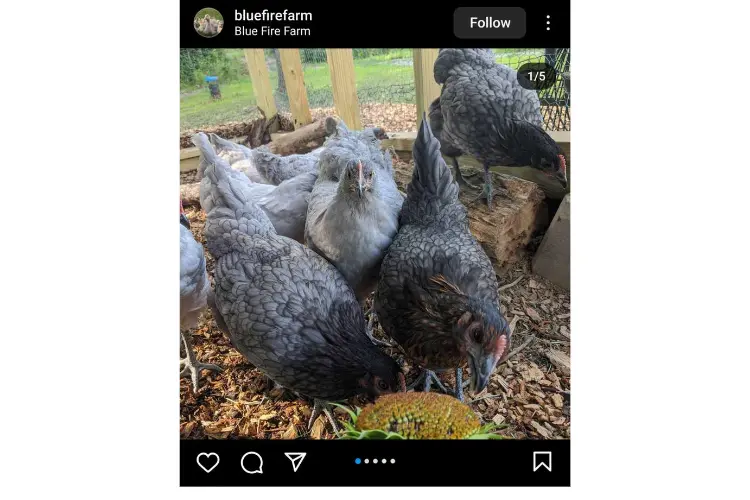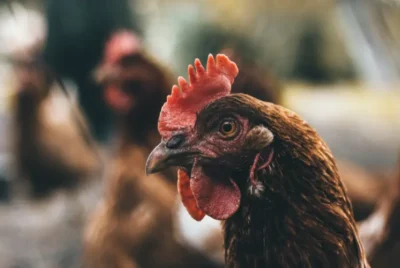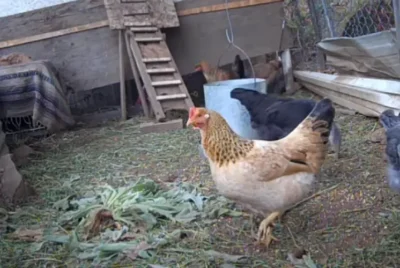An In-depth Look at the Rhode Island Blue Chicken Breed

While the Rhode Island Blue Chicken Breed promises an enticing blend of robust health, excellent laying ability, and high-quality meat, the lack of comprehensive, readily available information about this breed can be a significant pain point for poultry enthusiasts and farmers alike.
This makes it difficult for potential poultry breeders to make informed decisions about incorporating Rhode Island Blues into their flocks. So, we created this guide to navigate and learn about this certain breed. Keep on reading.
Table of Contents
What is a Rhode Island Blue Chicken?
The Rhode Island Blue is a breed that was developed in the United States to combine the robustness and productivity of the famous Rhode Island Red Chicken with a unique blue color. In 1904, the American Poultry Association said that this chicken breed was good and included them in their list of top chickens.
Rhode Island Blues is a highly productive breed, resulting from a hybrid crossing two of the most prolific egg layers – the Rhode Island Red and the Blue Australorp. This hybridization leads to a combination of blue, red, and black chickens.
Moreover, Rhode Island Blues can look and act differently from one another because they come from different families. They are not a type of chicken that follows specific rules, and how they are bred differs each time. So, depending on their family background, some of this breed may have different traits and qualities than others.

Benefits of the Rhode Island Blue Chicken
- Rhode Island Blue chickens are great for both laying eggs and providing meat, so they’re a flexible choice for any group of chickens.
- They’re often called ‘production birds’ because they lay many brown eggs, making them useful for egg production.
- People also appreciate these chickens because they’re tough and can survive different types of weather.
- Their blue feathers make them look different and more interesting than other chicken breeds.
- Rhode Island Blues can live comfortably in different settings, like small backyards or big farms.
- They’re also good at finding their food, which can help control bugs and lower the cost of feeding them if they have enough space to move around.
- On top of all that, they’re usually calm and friendly, so they’re good for families and people who raise chickens as a hobby.
Specifications and Unique Characteristics
The Rhode Island Blues is a distinctive breed that combines the hardiness and productivity of the Rhode Island Reds with the unique blue color of the Blue Australorp. They also have interesting things about how they look and act.
Physical Characteristics
Color
The special thing about Rhode Island Blues is their blue feathers, which they get from the Blue Australorp breed. Their feathers can be shades of blue, like light blue or darker blue. Sometimes, you might even see other colors mixed in, depending on the bird’s family tree.
Size
When Rhode Island Blues grow up, roosters are usually about 8-9 pounds. The hens are a bit smaller and weigh around 6-7 pounds.
Body Shape
Rhode Island Blues have a wide and strong body that shows they are good for making meat. They have a shape like a rectangle with a slightly deep chest.
Combs and Wattles
They generally have a single, upright comb and well-developed wattles, both red in color.

Behavioral Characteristics
Temperament
Rhode Island Blues are typically calm and friendly, making them suitable for backyard flocks and family pets. They are also known to be good foragers and are often quite active.
Hardiness
Rhode Island Blues are known for being strong and tough. They can live in different kinds of weather and are good for many places worldwide.
Laying and Meat Production Abilities
Egg Production
These chickens are excellent at laying eggs, even better than other similar-sized, multi-colored chicken breeds. They’re known as an egg-laying breed because they can lay around 260-290 big eggs yearly, starting at 18 to 20 weeks old.
This is much more eggs than other breeds like the Orpington, which usually lay about 175-200 eggs yearly. This shows that this breed is good at producing eggs. While Rhode Island’s Blue egg color is usually light brown, some people have said their eggs are more creamy, almost white.
What’s impressive is that these chickens can even sometimes lay eggs in the winter, showing they’re very strong and adaptable.
First Laying & Laying Span
Young hens, called pullets, start laying eggs quite easily and early. I suggest showing them where to lay their eggs when they are about 18 weeks old so they get used to it. Rhode Island Blues are good at laying eggs for a long time, often over 5 years.
Meat Production
Rhode Island Blue chickens are also great for producing meat. They’re quite big and have deep, wide bodies, providing a lot of high-quality meat. This makes them a good choice for people who want a chicken breed that is useful for laying eggs and providing meat.
Best Rearing Practices for this Chicken Breed
If you want to raise Rhode Island Blue chickens well, it’s important to understand what they need and to give them the right environment to grow and be productive. Even though they are generally strong and can adjust to different situations, certain ways to care for them can help them stay healthy and be as productive as possible.
Ideal Environment and Care
- Rhode Island Blues need a safe and dry coop with good airflow. The coop should have enough space for each chicken, with at least 2-3 square feet inside and 8-10 square feet outside. It’s important to protect the coop from animals that might harm the chickens and to have bars where they can sleep.
- I recommend that the outdoor area be fenced properly so the chickens don’t escape and avoid potential dangers.
- You should have enough boxes for the hens to lay their eggs. Usually, I suggest one box for every 4-5 hens is enough.
- Although Rhode Island Blues can handle different weather conditions, young chicks need a heat lamp until they grow feathers. In very cold weather, ensure the adult chickens have a warm, well-insulated house to prevent frostbite.

Ready to invest in a chicken coop that's built to last?
My recommended pick from Easy Coops is crafted from premium materials and designed for years of use. Give your chickens the ultimate shelter – check it now!
Don't wait any longer – check our in quality coop picks here. Tips and Advice for Optimal Rearing and Productivity:
- Make sure to give your Rhode Island Blues a balanced diet. Use starter feeds for chicks and layer feeds for adult hens as they provide the necessary nutrients. You can supplement them with occasional fresh fruits, vegetables, and grains.
- Always provide fresh and clean water for your chickens. In warmer climates or during the summer, check their water supply frequently to prevent dehydration.
- Regularly check the health of your chickens and make sure they receive necessary vaccinations. Deworming them regularly will help keep parasites away.
- Rhode Island Blues generally get along well with other chickens. However, keep an eye on their interactions when introducing new birds to prevent bullying.
- If possible, allow your chickens to roam freely. They are great at finding food that can supplement their diet while also giving them exercise. With proper care and nutrition, they can live for over 8 years.

Final Words
As we conclude our in-depth look at the Rhode Island Blues, it’s clear that their blend of unique blue plumage, robust productivity, and adaptability make them a worthy addition to any flock. Despite their relative obscurity, their potential is unmistakable – from superior egg-laying abilities to dependable meat yield and an endearing disposition.
To make the most of having Rhode Island Blues, it’s important to understand what they need and take care of them properly. We hope that learning about them has given you useful information about this special breed and that it helps you raise chickens successfully and makes you happy.
If you want to create your own shed and make your backyard the envy of the neighborhood with a unique shed creation. Browse our variety of shed designs and plans now.





Comments are closed.